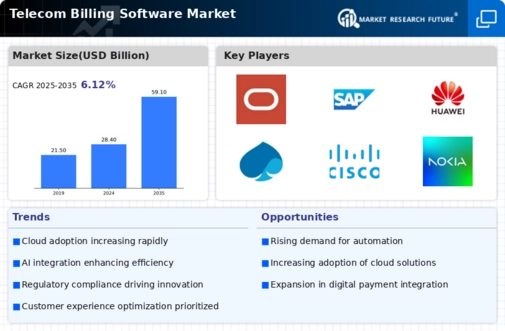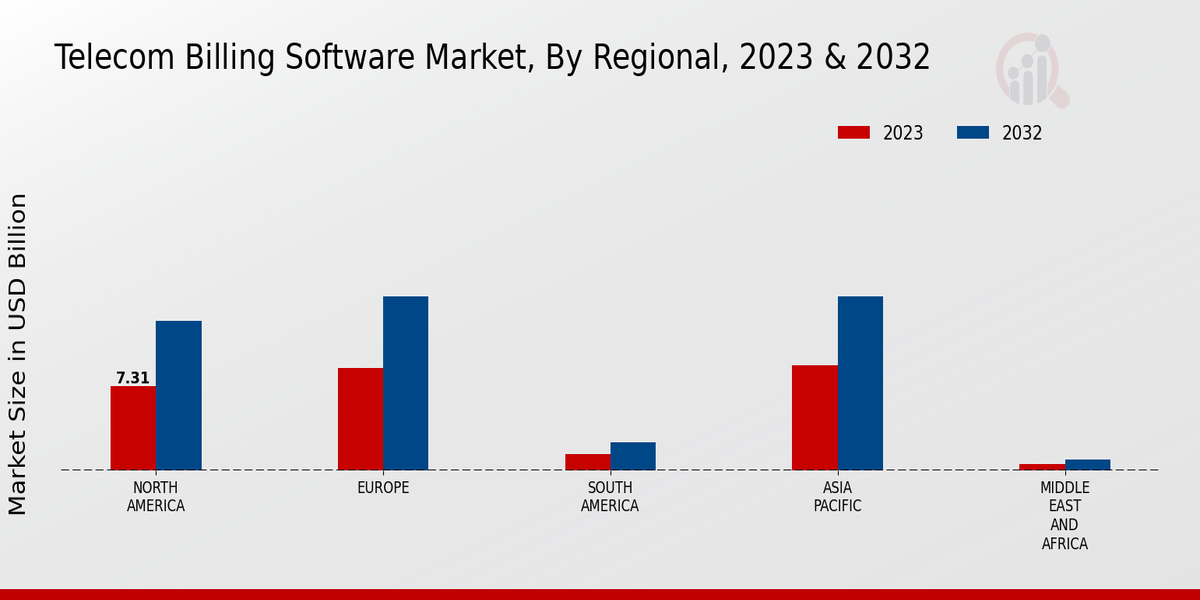Market Growth Projections
The Global Telecom Billing Software Market Industry is poised for substantial growth, with projections indicating a market size of 28.4 USD Billion in 2024 and an anticipated increase to 59.1 USD Billion by 2035. This growth trajectory suggests a compound annual growth rate (CAGR) of 6.9% from 2025 to 2035. The increasing complexity of telecom services, coupled with the demand for real-time billing and analytics, drives this expansion. As telecom operators seek to enhance operational efficiency and customer satisfaction, the adoption of advanced billing solutions will likely remain a focal point in the industry's evolution.
Emergence of 5G Technology
The rollout of 5G technology presents a transformative opportunity for the Global Telecom Billing Software Market Industry. As telecom operators invest in 5G infrastructure, they require advanced billing solutions to manage the complexities associated with new service offerings. 5G enables a plethora of applications, from IoT to enhanced mobile broadband, necessitating billing systems that can handle diverse pricing structures. This technological advancement is likely to drive market growth, as operators seek to capitalize on the potential revenue streams generated by 5G services. The market is projected to reach 59.1 USD Billion by 2035, underscoring the importance of innovative billing solutions in this new era.
Focus on Customer Experience
Enhancing customer experience is a pivotal driver in the Global Telecom Billing Software Market Industry. Telecom operators increasingly recognize that customer satisfaction is paramount for retaining subscribers and reducing churn rates. Billing systems play a crucial role in this endeavor by providing transparent and user-friendly interfaces for billing inquiries and payments. Operators are investing in solutions that offer personalized billing experiences, enabling customers to manage their accounts seamlessly. This focus on customer-centric billing solutions is expected to propel market growth, as companies strive to differentiate themselves in a competitive environment.
Adoption of Cloud-Based Solutions
The shift towards cloud-based solutions significantly influences the Global Telecom Billing Software Market Industry. Cloud technology offers scalability, flexibility, and cost-effectiveness, making it an attractive option for telecom operators. By migrating billing systems to the cloud, companies can reduce operational costs and improve service delivery. This trend is particularly relevant as the market is anticipated to grow at a CAGR of 6.9% from 2025 to 2035. The ability to access billing data remotely and integrate with other cloud services enhances operational efficiency, enabling telecom operators to respond swiftly to market demands and customer needs.
Regulatory Compliance and Standards
Regulatory compliance remains a critical driver within the Global Telecom Billing Software Market Industry. Governments worldwide impose stringent regulations on telecom operators to ensure transparency and consumer protection. Compliance with these regulations necessitates advanced billing systems capable of generating accurate reports and maintaining data integrity. As the market evolves, telecom companies must invest in billing solutions that not only meet current regulatory requirements but also adapt to future changes. This focus on compliance is expected to contribute to the market's growth, as operators seek to avoid penalties and enhance their reputation in a competitive landscape.
Increasing Demand for Digital Services
The Global Telecom Billing Software Market Industry experiences a notable surge in demand for digital services, driven by the proliferation of smartphones and internet connectivity. As consumers increasingly rely on digital platforms for communication, entertainment, and commerce, telecom operators are compelled to adopt sophisticated billing solutions. These solutions facilitate real-time billing, enabling operators to manage diverse service offerings effectively. The market is projected to reach 28.4 USD Billion in 2024, reflecting the industry's response to evolving consumer preferences. This shift towards digitalization necessitates robust billing systems that can handle complex pricing models and enhance customer satisfaction.
























